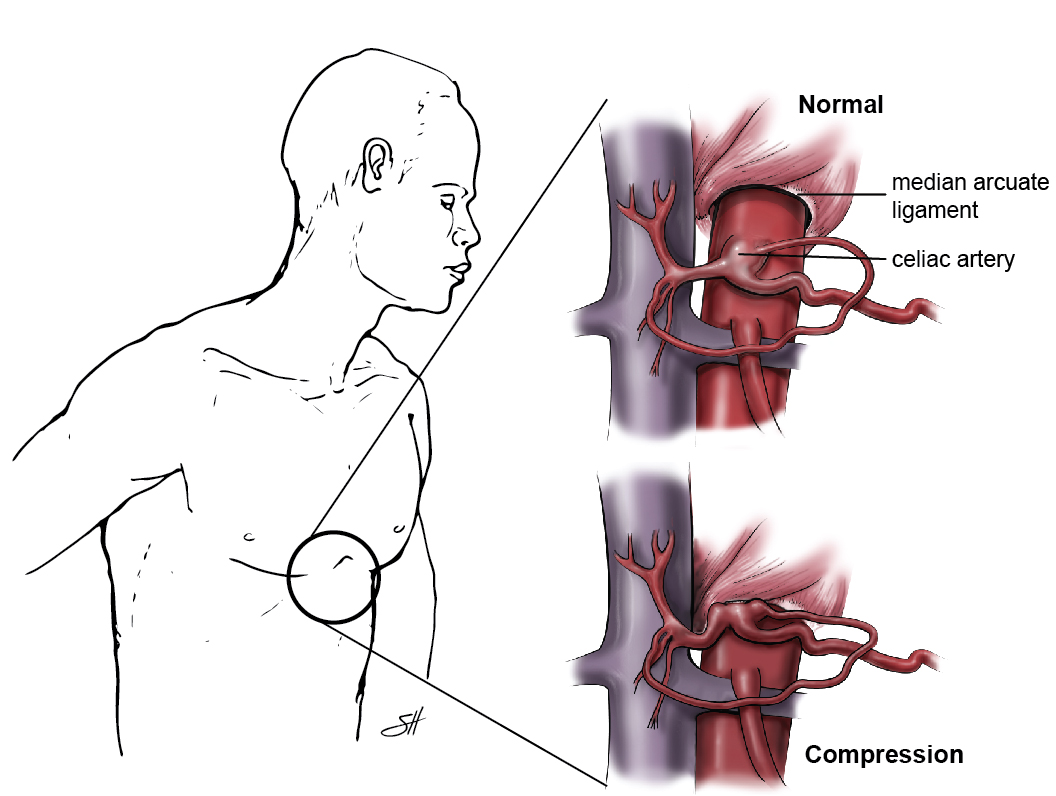What are the symptoms of celiac artery stenosis?
Patients with celiac artery compression syndrome may complain of abdominal pain in the epigastric area, anorexia, and/or diarrhea. Typically, the onset of the pain is after food intake (post-prandial pain). The pain may be associated with nausea and emesis.Aug 13, 2020
Celiac Artery Compression Syndrome - StatPearls - NCBI Bookshelf
Int J Surg Case Rep. 2020 Sep 28;76:64-68
Authors: Sharma S, Someshwar V, Ingale F
Abstract
INTRODUCTION: Celiac artery compression syndrome is a rare disorder found mainly in young females. It many a times goes undiagnosed as the symptoms are non-specific and varied.
PRESENTATION OF THE CASE: We present a case of celiac artery compression syndrome in a young female where laparoscopic median arcuate ligament release with celiac ganglionectomy was effective in relieving the symptoms.
DISCUSSION: Commonly they may present with abdominal pain, vomiting and diarrhea but there is absence of significant clinical signs. High level of suspicion and the right imaging techniques like the lateral aortogram, helps us to clinch the diagnosis.
CONCLUSION: Laparoscopic release of celiac artery compression is a safe and effective method to treat this uncommon disease.
PMID: 33011657 [PubMed - as supplied by publisher]
Why you should know about celiac artery compression syndrome
Do you experience pain in your stomach after you eat? Have you been experiencing weight loss?

If the pain occurs regularly and has been going on for several months, it might be a symptom of celiac artery compression syndrome.
Dr. Charles A. West, associate professor in the Michael E. DeBakey Department of Surgery and an expert in celiac artery compression syndrome, explains the rare syndrome and what you need to know about it.
Q: What is celiac artery compression syndrome?
A: Celiac artery compression syndrome, also known as median arcuate ligament syndrome, is a condition where a muscular fibrous band of the diaphragm, called the median arcuate ligament, compresses the celiac artery, which supplies blood to the upper abdominal organs.
Q: What are the symptoms?
A: The main symptoms are chronic abdominal pain that has lasted for several months; often times the pain may occur immediately after meals. Other symptoms may include weight loss, and sometimes an abdominal bruit, or the sound made by blood flowing through an obstruction.
Q: Why should people be aware of this syndrome?

A: It could be the cause of persistent abdominal pain that has not been treated successfully. This condition is generally not life threatening, but it is debilitating.
Q: How can it be diagnosed?
A: The doctor will get familiar with the patient’s clinical history, and will do a physical exam followed by an imaging study of the visceral and intestinal arteries.
Often the first imaging test is a duplex ultrasound, which may be followed by a computed tomography (CT) angiogram or a conventional angiogram.
Q: How is it treated?
A: Surgery is the recommended treatment. This can be performed from an incision in the upper abdomen, which allows the doctor to surgically release the constraining ligament.
In some cases, the procedure can also be performed laparoscopically; releasing the constraining ligament using a thin tube, the laparoscope, inserted through a small incision in the abdomen. Sometimes, a bypass procedure is required to restore the blood supply to the affected area.
Q: Does the treatment cure the disease?
A: Some people respond better than others. The patients who have significant abdominal pain after eating and have lost significant weight from the condition usually have a better response to surgical treatment than patients who have less pain and weight loss. Women younger than 60 years also tend to respond better than older patients.
If you have had abdominal pain for months, especially after eating, and have not treated it successfully, consider consulting with a vascular surgeon about the possibility that celiac compression syndrome might be the cause of your problem.
For more questions about celiac artery compression syndrome or to schedule a consultation, call 713-798-5700.
No comments:
Post a Comment